Discover
Aden – Colonisation
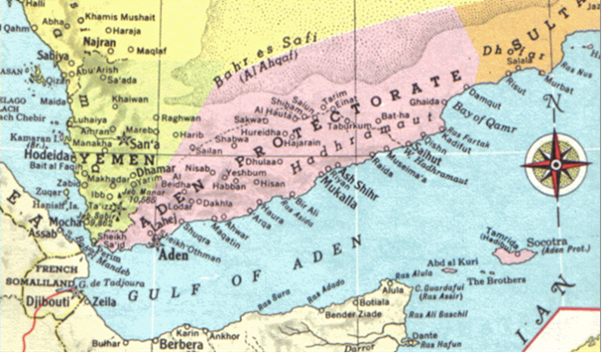
Unveiling Legacy
Interesting Facts
Timeline of Colonisation
1837 – Britain seizes port of Aden
Administered from Bombay in India
1842 p&o Establish a coal depot
The Peninsula and Oriental steam ship company establish a call depot at Tawahi
1849 – Turkish forces occupy the port of Hodeida and parts of the coastal plane
1850-1860 – drought, famine and disease
“Economic decline was accompanied by political disintegration and for much of this period the country was ruled by one or other of the great tribal confederations”3
1869 the suez canal opens
“The volume of traffic using the port increases dramatically in 1869 and again in the 1870s and 1880s as freighters switch from sail to steam’4
1872 Turkish troops, declare Yemen a province of the Ottoman Empire
.
1880- britain proposes protectorate treaties
Signed between 1888 and 1903 “with tribal rulers in the Aden hinterland and further east in the politically sensitive Hadramaut”5.
1891 – Imam Yahya revolts agains the turks
There is another revolution in 1899, 1904-1905, 1911 tries to take Sana’a
1911- treaty signed at da’an
Between the new Turkish governor and the Imam. The Imam controls. Zaidi districts, has power to appoint all governance and judges, becomes a Turkish ally and receives an annual subsidy of 2500 Turkish gold pounds. The Imam support the Turks in World War I.
1918 – Imam becomes successor to Turkish governor general
The Ottomans withdraw from Yemen.
1919- imam invades part of the western protectorate
“In 1928 the Royal Air Force attacked target across the Yemen border and restored most of the form of boundary agreed with the Turks in 1905”6
1934 – The Anglo Yemeni Treaty was signed
“The British government finally recognise the independence of Yemen”7 p37
1937- Aden becomes a crown colony separate from British India
1948 – Imam Yahya dies And is succeeded by son, Ahmed
Ahmed renews his ambitions to secure independence from the British and imposes a harsh taxation system oppressing Yemen’s shafi’is.
1962 – Imam Ahmed dies and is Succeeded by his son Muhammad Al- Badr
One week later he is overthrown in a coup launching the North Yemen civil war and declaring then Yemen Arab Republic
1963 – the Aden Emergency Began
Nationalist groups such as the national liberation front (NLF) and the front for the liberation of occupied South Yemen (FLOSY) began a violent insurgency against the British carrying out attacks to force them out.
1967 – The British evacuate
Local armed resistance, changing British colonial policy in the 60’s and rising Arab nationalism all contributed to Britain no longer being able to sustain rule of Aden.
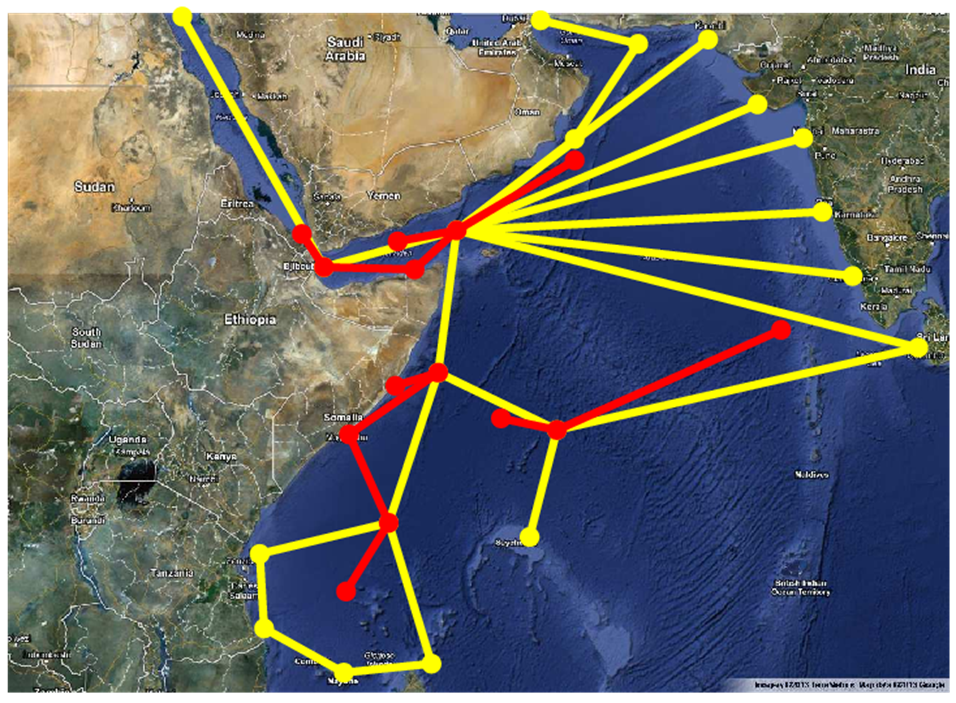
Siege of Aden
There are mixed accounts of the siege of the port. Some sources state that British captain, Stafford Haines set in place a decoy British protected vessel, ‘run aground’ on the coast of Aden to tempt looters and thus provide the British with the excuse they needed to seize the port and employ a presence. Occupying Aden gave the British immediate access to African and Arabian coasts and a place to re-fuel ships mid-voyage.

British Postcard Captain J S Rundel

Initially, British efforts were largely focused on capitalising on Aden as a centre for trade. It’s close proximity with the horn of Africa and valuable commodities in Yemen such as coffee opened the door to opportunity which left Aden prosperous.
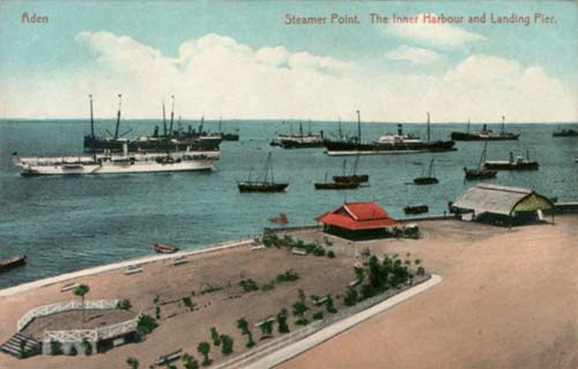
All Yemenis leaving Yemen by ship sailed from here 12
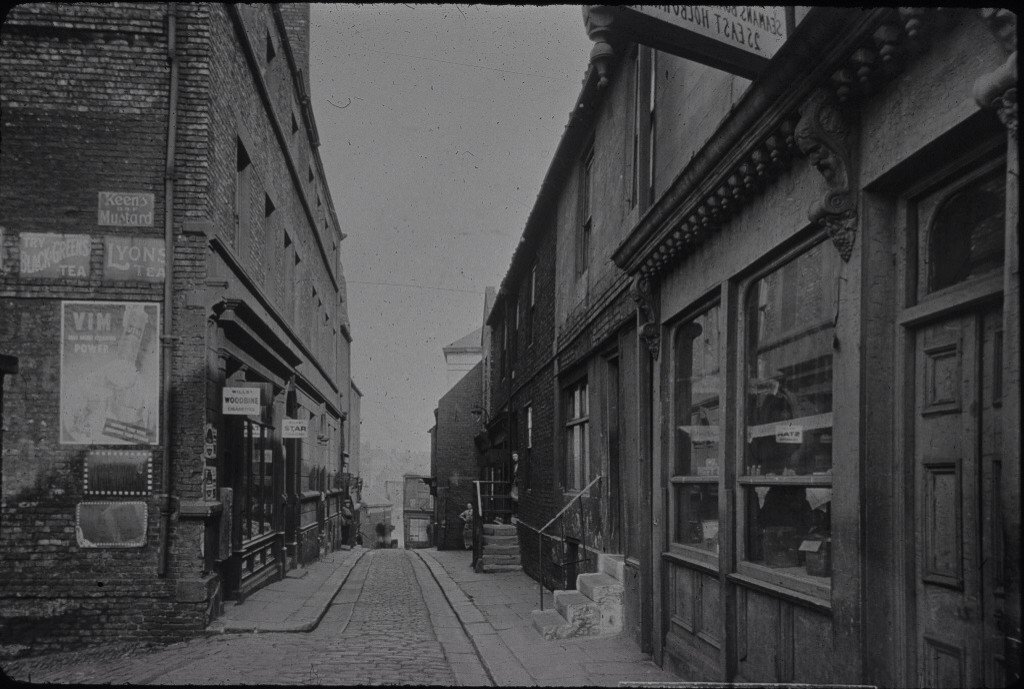
South Shields, Holborn (c) South Tyneside Libraries
During the 129 years that the British occupied Aden, a delicate political dance was enacted between the British authorities the Ottoman Empire, the Imamate and local tribal leaders. Yemen itself went through large periods of drought famine and difficult living conditions which pushed labourers from all across Yemen to leave their homes and seek work on the ships of both of British and other European governments who docked in Aden. The methods and systems to secure employment were riddled with bribery and corruption. Lawless states “the supply of labour was controlled and organised by a system of brokers or labour contractors. Each major employer at Aden had his chief broker often referred to as muqaddems or serangs, who in turn employed several sub-muqaddems who recruited the men and were responsible for paying their wages, finding accommodation for them and making sure they were fed.” 18
British Yemen Migration timeline
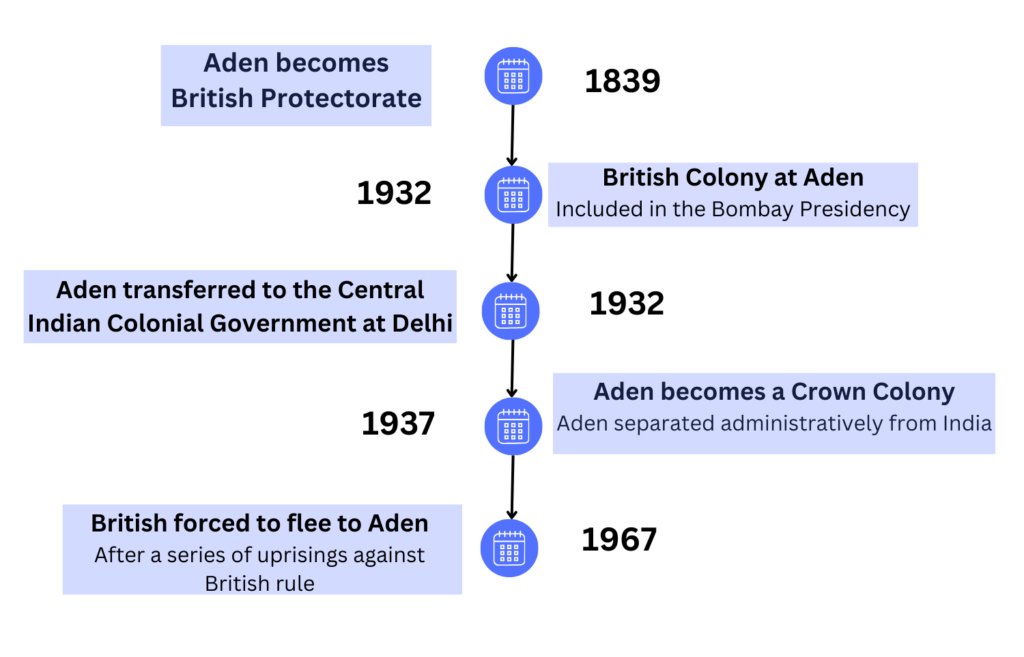
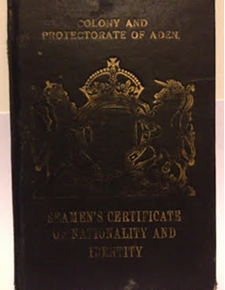
https://www.youtube.com/watch?v=e6i30SWqYW0
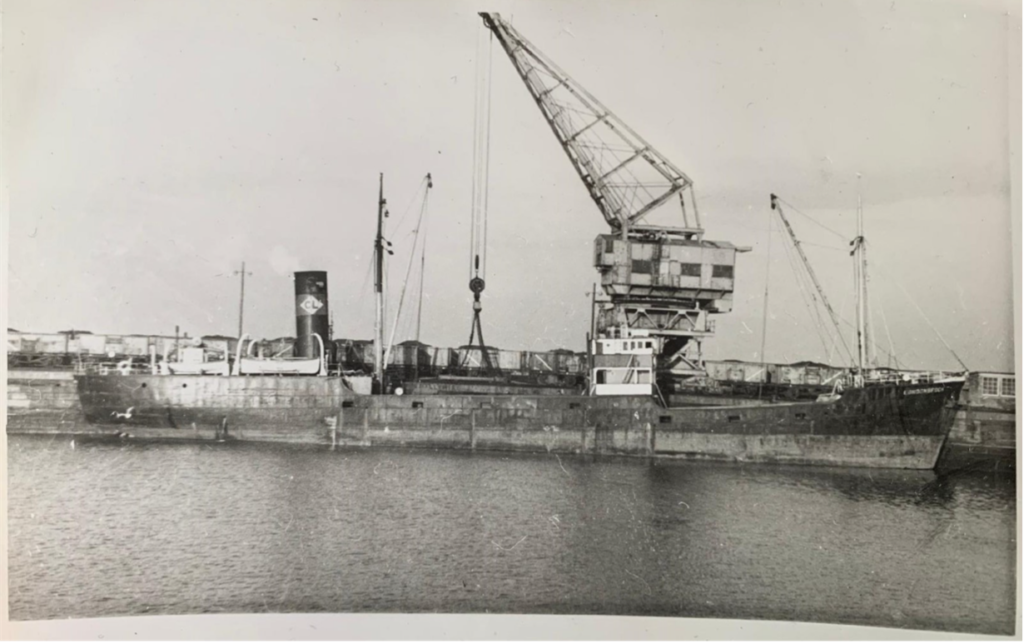
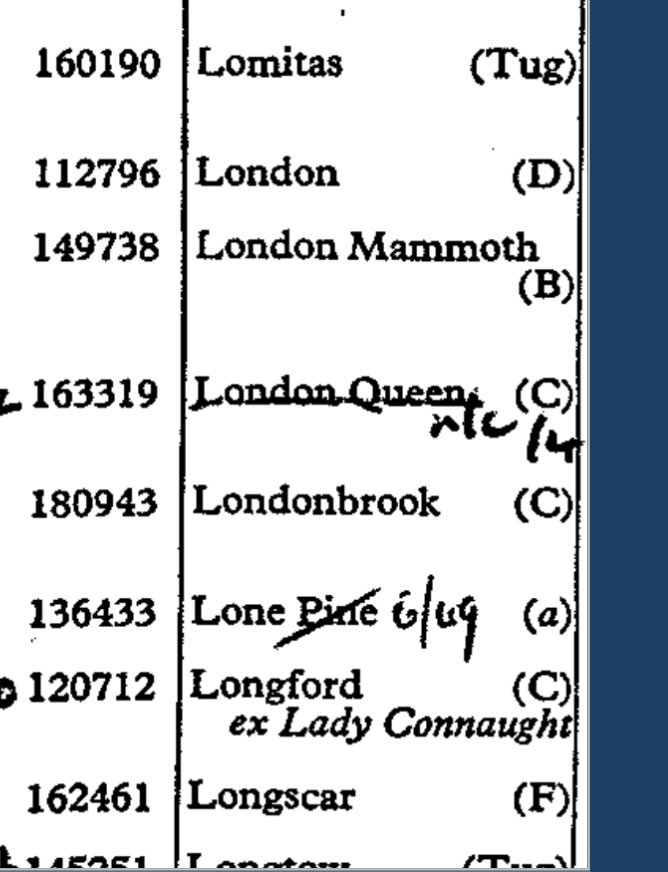
List of ships – crew list for Londonbrook
Impact on Yemenis
Opinions on the impact of colonization on Yemen are subjective. There are some, such as Saeed Ghaleb who enjoyed life under colonial rule and formed a lifelong bond with his employer. Others, see things differently. Abdul Galil Shaif Kasim’s father came from Sha’ib and said:
‘24 hours from Sha’ib to Aden by car, who accepts that? whilst the British brought rule, order and administration, the Yemeni people were not able to develop as Yemenis for example, in 129 years there were only 4 schools for 14 million people’20
The consequences of such depravation on the local population were such that most were (and still are) forced to seek employment outside of Yemen whilst local resources such as fish and honey were capitalized on by the British occupation.
He states that ‘in 1962, the British promised the UN that they would given 60 million pounds to Aden in damages for the impact of their colonial rule and retracted upon the promise leaving the NLF and FLOSY (National Liberation Front/ Front of the Liberation of Occupied South Yemen) to fight among themselves’.
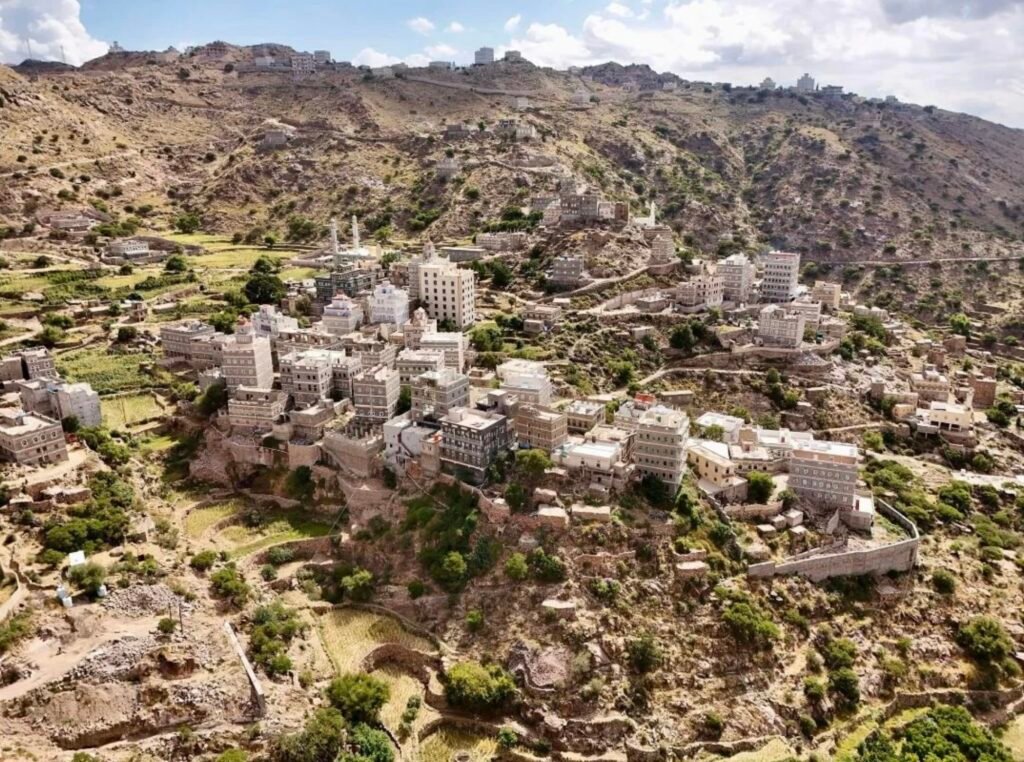
Colonial Violence & Racism

Violence and racism were hallmarks of the British occupation of Aden and whilst the Yemenis were suffering at the hands of brutal colonial rule in Aden, they were also in South Shields facing active calls from a large part of the local population for their deportation and having their rights progressively restricted by the implementation of legislation after legislation.
“Credible source material shows South Yemenis placed by British soldiers in concentration camps behind barbed wire 22”
“Amnesty International’s report of 1966 detailed that the British had used torture in Aden including removing detainees’ clothes and interrogating them naked, hitting their genitals, stubbing out cigarettes on their skin, making them sit on poles directed at the anus and sleep deprivation 23
“The idea of having good roads and services does not mean they (the colonisers) were good ” – Abdul Galil Al-Shaibi

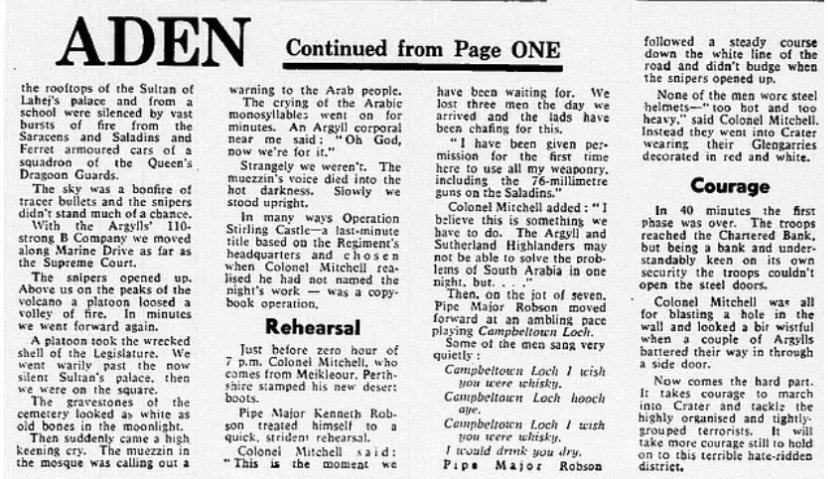
https://www.dailymail.co.uk/news/article-12964331/Mad-Mitch-British-Empire-Yemen-Aden.html

Britain exits Aden – 1967
Yemeni aspirations for self-rule and an end to 129 years of colonisation could not be supressed by Mad Mitch or military intervention.
By the time of British withdrawal many South Arabian soldiers and policemen were openly aiding the insurgents. In one example on 20th June 1967, the South Arabian Police attacked British forces in locations across Aden provoked by rumours of a British attack on a South Arabian Army bases
Despite hoping for a long, drawn out withdrawal and hoping to continue having influence, Adeni attacks on British forces continued and the National Liberation Front continued to seize more and more control.
The Federal government ceased to exist in September and High Commissioner Trevelyan sought negotiations with the nationalist groups over Britain’s inevitable withdrawal. Yet attacks on British forces by the NLF continued, forcing the quickening of the evacuation. Trevelyan, and therefore British government, left Aden from RAF Khormaksar on 28 November 1967.



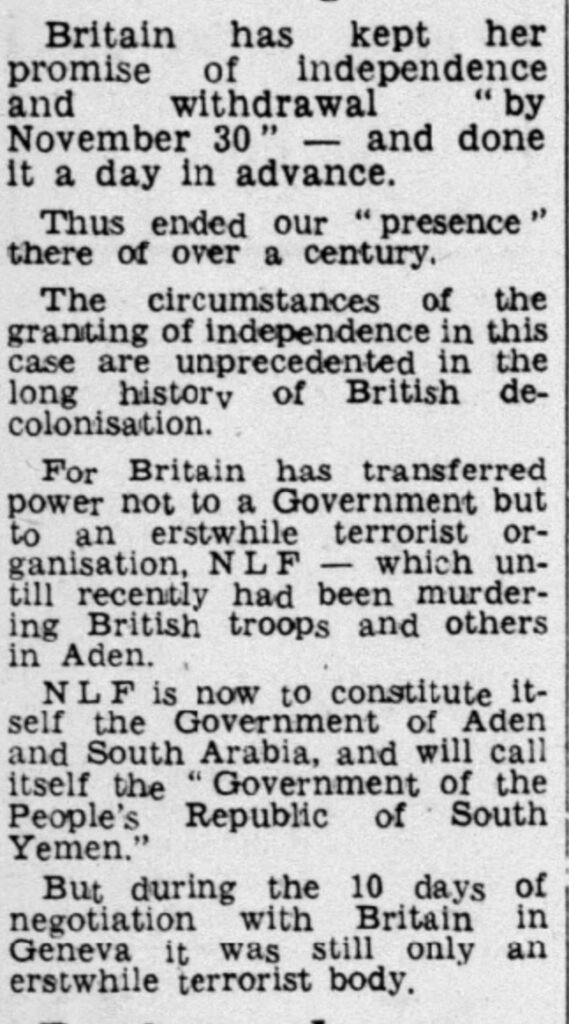
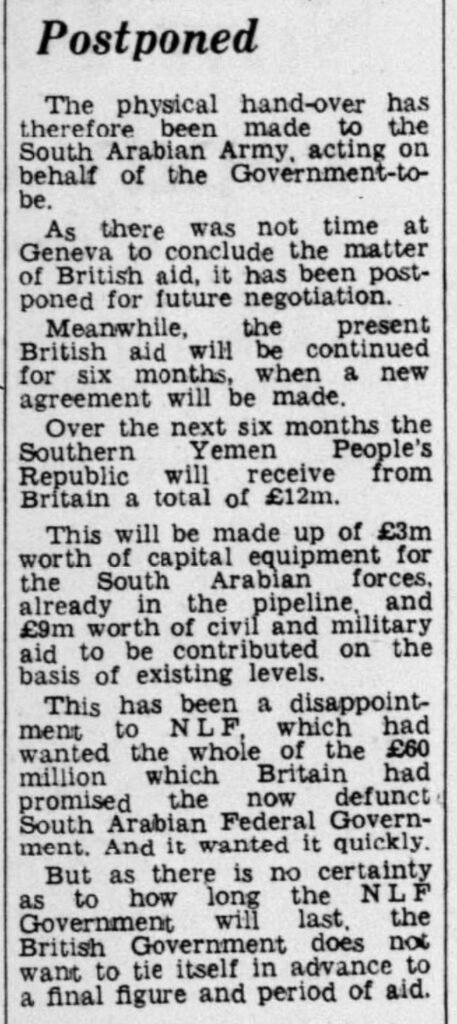
As the National Liberation Front intensified its violent campaign for independence, the British increasingly felt that their presence in Aden was unsustainable. Attacks continued
“British forces had withdrawn from the outer parts of the country, with the NLF assuming control as they did so. By August the NLF were in charge in 12 states. The Federal government ceased to exist in September and High Commissioner Trevelyan sought negotiations with the nationalist groups over Britain’s inevitable withdrawal. Yet attacks on British forces by the NLF continued, forcing the quickening of the evacuation. Trevelyan, and therefore British government, left Aden from RAF Khormaksar on 28 November 1967”25
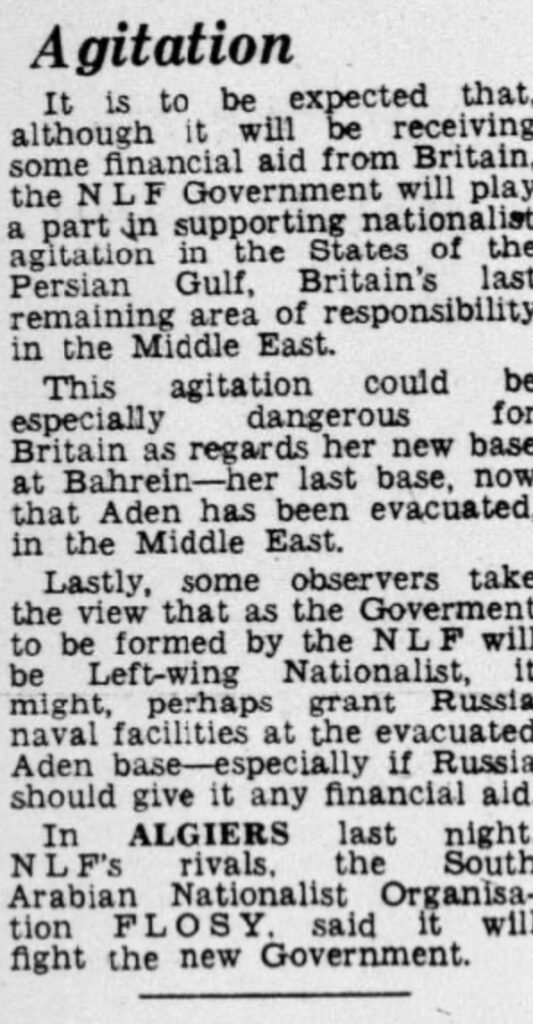
(c) Birmingham daily post 30/11/1967
- Gavin, R, (1994), “The Port of Aden – A Brief History’, in The Port of Aden Annual, Ta’izz: Genpack, p, 5. ↩︎
- www.therobinsonlibrary.com. (n.d.). Aden Protectorate. [online] Available at: http://www.therobinsonlibrary.com/history/asia/arabian/regions/aden-protect.htm [Accessed 21 Jun. 2023] ↩︎
- Lawless, R.I. (1995). From Taʻizz to Tyneside. p35.
↩︎ - Ibid. ↩︎
- Ibid.. ↩︎
- Ibid., 36 ↩︎
- Ibid., 27 ↩︎
- https://www.researchgate.net/figure/Map-of-the-Gulf-of-Aden-with-vessel-routes-Yellow-routes-are-routes-for-transport-and_fig2_271003712m ↩︎
- Wikipedia Contributors (2019). History of Yemen. [online] Wikipedia. Available at: https://en.wikipedia.org/wiki/History_of_Yemen ↩︎
- Seddon, M, (2014), Last of the Lascars, p. 52 ↩︎
- Ibid ↩︎
- atlantic-cable.com. (n.d.). History of the Atlantic Cable & Submarine Telegraphy – CS Sherard Osborn. [online] Available at: https://atlantic-cable.com/Cableships/SherardOsborn/index.htm [Accessed 21 Jun. 2023]. ↩︎
- Seddon, M, (2014), Last of the Lascars, p. 53 ↩︎
- Ibid ↩︎
- ↩︎
- Seddon, M, (2014), Last of the Lascars, p. 54 ↩︎
- Ibid. ↩︎
- Lawless, R.I. (1995). From Taʻizz to Tyneside. p. 12 ↩︎
- ↩︎
- Abdul Gailil Al Shaibi
21. journalist, A.Y. (2022). Britain’s complex colonial legacy in Yemen. [online] https://www.newarab.com/. Available at: https://www.newarab.com/analysis/britains-complex-colonial-legacy-yemen. ↩︎ - Center, S. (2022). The Man Who Tried to Kill South Yemen’s Political Awakening – Mad Mitch. [online] South24 Center. Available at: https://south24.net/news/newse.php?nid=2411.
↩︎ - Ibid ↩︎
- journalist, A.Y. (2022). Britain’s complex colonial legacy in Yemen. [online] https://www.newarab.com/. Available at: https://www.newarab.com/analysis/britains-complex-colonial-legacy-yemen.
↩︎ - Imperial War Museums. (n.d.). Why did British troops leave Aden?[online] Available at: https://www.iwm.org.uk/history/why-did-british-troops-leave-aden. ↩︎
- Ibid ↩︎
